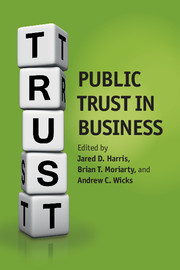Book contents
- Frontmatter
- Contents
- List of figures
- List of tables
- Notes on contributors
- Preface: discovering new territory in public trust in business
- Acknowledgments
- 1 Public trust in business: what’s the problem and why does it matter?
- Part I Trusting the institution of business
- Part II Public trust and business organizations
- 7 Public trust and trust in particular firm–stakeholder interactions: a theoretical model and implications for management
- 8 Creating more trusting and trustworthy organizations: exploring the foundations and benefits of presumptive trust
- 9 Building trust through reputation management
- 10 Can trust flourish where institutionalized distrust reigns?
- 11 Roles of third parties in trust repair: lessons from high-tech alliances for public trust
- 12 The repair of public trust following controllable or uncontrollable organizational failures: a conceptual framework
- 13 Toward a better understanding of public trust in business
- Index
- References
13 - Toward a better understanding of public trust in business
Published online by Cambridge University Press: 05 July 2014
- Frontmatter
- Contents
- List of figures
- List of tables
- Notes on contributors
- Preface: discovering new territory in public trust in business
- Acknowledgments
- 1 Public trust in business: what’s the problem and why does it matter?
- Part I Trusting the institution of business
- Part II Public trust and business organizations
- 7 Public trust and trust in particular firm–stakeholder interactions: a theoretical model and implications for management
- 8 Creating more trusting and trustworthy organizations: exploring the foundations and benefits of presumptive trust
- 9 Building trust through reputation management
- 10 Can trust flourish where institutionalized distrust reigns?
- 11 Roles of third parties in trust repair: lessons from high-tech alliances for public trust
- 12 The repair of public trust following controllable or uncontrollable organizational failures: a conceptual framework
- 13 Toward a better understanding of public trust in business
- Index
- References
Summary
The research compiled in this volume, the consistently dismal poll results, and continued public interest in the role of business in society give rise to a number of opportunities to further improve our understanding of public trust in the institution of business. One of our primary objectives in commissioning these chapters was to stimulate further scholarly thinking and research on the subject of trust in the institution of business; as such, a number of questions offer potential avenues for additional analysis and inquiry.
Definition and antecedents
We need a better conceptual understanding of what constitutes “public trust” and how we might define it in terms that build on the existing literature and extend our theoretical understanding. Given the potential importance of trust in business as an institution, there is an opportunity for scholars to bring more precise understanding to what exactly respondents are talking about when they talk about public trust in business writ large. How much of one’s trust in business as an institution arises from one’s direct experiences with various specific businesses? How much is attributable to a particular stakeholder role or mindset? How is one’s generalized trust in business influenced by observations about others’ experiences, or the observed behavior of firms with which one has no direct experience? We need to better understand the drivers of trust in business as an institution. Several chapters in this volume begin to offer theory about how public trust is formed, but many questions remain.
- Type
- Chapter
- Information
- Public Trust in Business , pp. 361 - 368Publisher: Cambridge University PressPrint publication year: 2014

